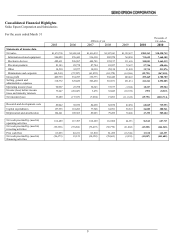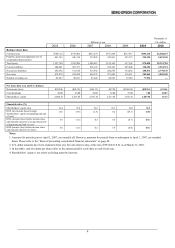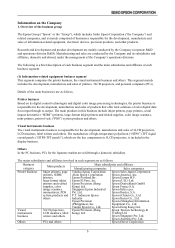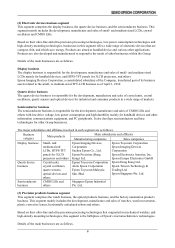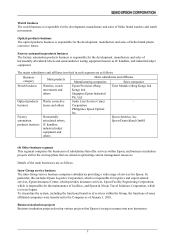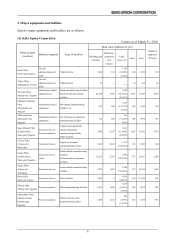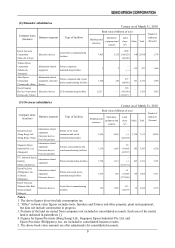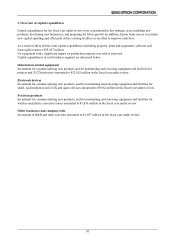Epson 2010 Annual Report Download - page 14
Download and view the complete annual report
Please find page 14 of the 2010 Epson annual report below. You can navigate through the pages in the report by either clicking on the pages listed below, or by using the keyword search tool below to find specific information within the annual report.
13
Risks Related to Epson’s Business Operations
1. Epson relies to a significant degree on sales and profits from its printer business
Epson’s ¥712,692 million in sales from its information-related equipment business for the year ended March
2010 constituted 72.3% of Epson’s consolidated sales, which were ¥985,363 million. Inkjet and other printers,
including printer consumables, accounted for a large majority of the sales and profits of the information-related
equipment business. A decrease in sales of inkjet printers and printer consumables could have a material adverse
effect on Epson’s results.
2. Price competition causes a downward trend in prices
Market prices for printers, projectors and other information-related equipment have been on a continuous
decline due to intensified competition and a shift in demand toward lower-priced products. Meanwhile, prices
for crystal devices and color LCDs for mobile phones are being driven down across the board due to intensified
competition and other factors, and other products could be similarly affected. Epson is striving to improve
profitability by reducing production costs, for example, by using low-cost designs, and is taking measures to
fight the trend of declining prices, for example, by expanding sales of high-value-added products. However,
there is no assurance that these efforts will succeed, and if Epson is unable to respond effectively to counteract
the downward price trend, its results might be adversely affected.
3. Epson’s technologies compete with the technologies of other companies
Some of the products that Epson sells contain technology that place Epson in competition against other
companies. For example:
1) Epson’ s Micro Piezo technology*1 that it uses in its inkjet printers competes with the thermal inkjet
technologies*2 of other companies; and
2) Epson’ s 3LCD technology*3 that it uses in its projectors competes with other companies’ DLP*4 and
LCOS*5 technologies.
Epson believes the technology it uses in these types of product is superior to the alternative technologies of
other companies, but, if consumer opinion with respect to Epson’ s technology changes, or if other
revolutionary technologies appear on the market and compete with Epson’ s technologies, Epson may lose
that competitive edge and its results might consequently be adversely affected.
*1. Micro Piezo technology is an inkjet printer technology created by Epson that manipulates so-called
piezoelectric elements to fire small droplets of ink from the printer nozzle.
*2. Thermal inkjet technology is a type of technology for printers whereby the ink is heated to create bubbles
and the pressure from the bubbles is used to fire the ink (also sometimes referred to as bubble jet
technology).
*3. 3LCD technology is a technology whereby TFT panels are used as light valves. The light from the light
source is divided into the three primary colors (red, blue and green) using special mirrors, the picture is
created on separate LCDs for each color and then the picture is recombined and projected on the screen.
*4. The DLP technology is a technology that uses a digital micro-mirror device (DMD) as a display device. A
DMD is a semiconductor on which between hundreds of thousands and millions of micro mirrors are
arranged, each mirror directing light onto its own individual pixel, and the image is created by the light
from the light source being reflected from the mirrors onto the screen. DLP and DMD are trademarks of
Texas Instruments Incorporated.
*5. LCOS technology is a technology that uses liquid crystal on silicon (LCOS ) as a display device. It is
characterized by the extremely large number of openings on the surface of the reflective LCD panel.
Because the circuits and the switching elements are etched underneath the reflective layer, there is no need
for the BM (a light-blocking layer that prevents light from falling on the pixel transistor area), making for a
seamless display of the picture.
4. Epson might experience a reduction in the market share of genuine consumables
Ink cartridges are particularly important inkjet consumables in terms of Epson’s sales and profit. There are other
parties who supply ink cartridges that can be used in Epson printers. These alternative products are sold for less
than genuine Epson ink cartridges and, while they have relatively low market share in Japan and America, they
have high market share in certain Asian countries. Against the risk posted by a decline in the share of genuine


